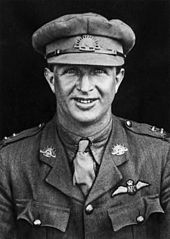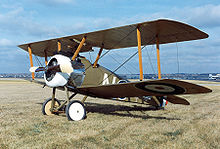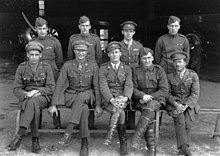Elwyn Roy King
Elwyn Roy King , DSO , DFC (* 13. May 1894 , † 28. November 1941 ) was an ace in the Australian Flying Corps (AFC) during the First World War . He scored 26 victories in dogfights, making him fourth among the Australian pilots with the most victories in World War I. only three separated him from Harry Cobby . Between the world wars he worked as a civilian pilot and engineer . From 1939 until his death he served again in the Royal Australian Air Force (RAAF).
Life
Early years
Elwyn Roy King was born on May 13, 1894, the eldest child of Richard and Elizabeth Mary King (née Miller) on "The Grove" in the Bathurst area, New South Wales . He attended a public school and trained as a mechanic through correspondence courses . He initially earned his living repairing bicycles, automobiles and clippers.
First World War
On July 20, 1915, King joined the Australian Imperial Force and was shipped to Egypt in October of the same year , where he served with the 12th Light Horse Regiment from February 1916. In December 1916 he was transferred to the Australian Flying Corps (AFC) as an aircraft mechanic. In this role he was brought to England, where he was trained as a pilot shortly afterwards. On March 21, 1918, he was named No. 4 Squadron of the AFC in France as a fighter pilot . On the same day, the German troops in France launched their 1918 spring offensive with the Michael company .
The No. 4 Squadron of the AFC was stationed in Bruay at the time. As early as March 20, 1918, the pilots had received the order to extend their patrols to the area south of the Scarpe as far as the area around Bapaume , since this area was believed to be the main thrust of the German attack. The Sopwith Camel equipped pilots of the Squadron flew mainly attacks on ground troops in a row, in order to hinder the German advance and to give the Allies time to build a new line of defense. The Squadron's attacks focused on ground targets around Bapaume, Vaulx-Vraucourt and the road between Bapaume and Cambrai . There were hardly any opportunities for dogfights. Kings Squadron was intended solely for ground targeting, while No. 2 Squadron provided the necessary air cover and intercepted attacking aircraft of the German air force . King also had difficulties with his Sopwith Camel. The cockpit of the machine was too narrow for the more than 1.9 m tall and powerfully built King and he had problems being able to pull the control stick back far enough, especially when landing. The problem could only be solved after the No. 4 Squadron had been equipped with the more spacious Sopwith Snipe .
After the German advance towards Arras was finally flagged on March 28, 1918, the activities of No. 4 Squadron north to the Leie area . The section of the front was considered “relatively calm” until the German spring offensive extended to this area in early April and escalated from April 7, 1918 in the Fourth Battle of Flanders . The No. 4 Squadron was again exclusively occupied with combating ground targets.
At the end of April 1918 the airfield of No. 4 Squadron relocated to the Clairmarais area. The task of the Squadron increasingly shifted to fighting enemy aircraft, especially artillery observers . On May 14, 1918, King scored his first victory in an aerial combat. The shooting down of a two-seat artillery observer in the area between Ypres and Bailleul could not be confirmed. He scored his first confirmed kill a few days later on May 20, 1918.
On June 1, 1918, King was promoted to First Lieutenant . In the same month he destroyed an artillery observation balloon near Estaires (June 20) and shot down a Pfalz-Jäger near Armentières (June 26) and a two-seater LVG near Mesen (June 28). In July the No. 4 Squadron relocated to an airfield near Reclinghem , which is the No. 2 Squadron of the AFC. Subsequently, a contest arose between the two Australian squadrons over the number of confirmed kills. By the end of the month King had two more kills, again a two-seater LVG north of Armentières on July 25 and four days later, also at Armentières, a Fokker double-decker . By early August, the Australians' offensive patrol flights had become routine, and King had recorded four more kills (three two-seat reconnaissance aircraft and an artillery observation balloon) by the 10th of the month. In addition to the aerial battles, mainly German supply lines, depots , trains, track systems and stations were bombed.
On August 8th, the Allied counterattack was initiated with the Battle of Amiens . Parts of No. 2 and the No. 4 Squadron, including King, were transferred to Allonville on August 12th to support the attack from there. However, the Australians rarely encountered enemy aircraft during their patrols. On August 13, King was flying in a group of six Sopwith Camels when the patrol west of Péronne encountered a lone Albatross two-seater . All six camels attacked simultaneously and shot down the enemy. The other patrols had hardly any successes and one finally had to realize that the few kills were not worth the effort. On August 14th, King and his comrades were ordered back to their original deployment area on the Leie.
On August 16, King was involved in a major attack on a German airfield near Haubourdin . All aircraft available within range of the target, a total of 65 aircraft, were armed with incendiary and high-explosive bombs and machine-gun ammunition to the limit of their carrying capacity . King flew second on the line of scrimmage behind Cobby, destroyed a hangar with three of his bombs on his first approach to the target and set another one on fire with his fourth and final bomb. Then he turned his machine, flew a full lap over the enemy airfield on the second approach and fired his on-board machine gun at every target in his field of vision, storehouses as well as accommodations and searchlights. The following pilots completed the work of destruction. A day later, a similar attack on a German airfield near Lomme followed .
In the days that followed, bad weather hampered the pilots' activities. On August 25, King penetrated, alone on patrol, as far as Don , bombed the station there, shot a train with his on-board machine-gun and returned to the base without seeing a single enemy aircraft. It wasn't until August 30th that King was able to get another confirmed kill on his list. The German air forces had largely withdrawn from this section of the front after the devastating attacks on Haubourdin and Lomme.
In September, King became the Captain transported and as a flight leader used ( "Flight Commander"). He had 18 confirmed kills by the end of the month. On October 2, 1918, he added another, now his fourth, artillery observation balloon to his hit list. It was the last kill he got with his Sopwith Camel. Shortly thereafter, the No. 4 Squadron equipped with the new Sopwith Snipes . Up until the Compiègne armistice on November 11, 1918, King had seven more kills with the new machine, including six Fokker D.VII fighter planes. With this King achieved the highest number of kills with a machine of this type.
The high number of kills during the last days of the war was also due to the fact that large units of the German air forces were relocated to the northernmost section of the front to cover the retreat of the ground troops from Belgium. From October 29 to November 4, the area was the site of the most violent aerial battles of the entire war, involving large numbers of aircraft from both sides. On October 30, King led his swarm ("A-Flight") as escort for a bomber attack on an enemy airfield near Rebaix . The attack was disrupted by German Fokker fighters and King took up the fight. He managed to shoot down one of the enemy fighters. However, he was then attacked by four other Fokker fighters at the same time. King used the improved climbing performance of his new machine to climb through the middle of the opposing formation and strike again from an elevated position. However, according to his own statements, he had overlooked one of the enemy machines and came dangerously close to it during the maneuver. The German pilot turned to avoid a collision, in turn collided with another aircraft from his own formation and both Fokker crashed badly damaged.
From October 31, bad weather set in and prevented large-scale air strikes on both sides. On November 4th the weather improved and the last major air battle of the First World War broke out. Around noon all available Allied machines rose to attack the German retreat along the road between Leuze and Ath and an airfield near Chapelle-à-Wattines . King's swarm had been instructed to guide the bombers safely back across the front line when a formation of 12 Fokker fighters appeared. King turned back with his swarm and shot down the leader of the enemy formation. Then he turned and shot down another chaser that was chasing one of the men in his swarm. On November 10th, No. 4 Squadron the No. 2 Squadron again as escort during bombing raids on Enghien train station . A day later, the mutual killings came to an end and the Compiègne Armistice was signed.
Interwar period
After the war, King was No. 4 Squadron from December 7th, initially in Euskirchen and later on an airfield in Bickendorf near Cologne as an occupation soldier. King returned to Australia only in June 1919, and on August 11, 1919, he was officially discharged from military service.
Back in civilian life, King initially worked as a civilian pilot, mainly at Larkin-Sopwith Aviation Co. of Australasia Ltd, and gained a certain reputation through several maiden flights in the postal and communications sector. At the beginning of the 1920s he gave up flying and founded his own company with a former pilot comrade. Shipman, King & Co. Pty Ltd imported machinery, manufactured its own products and was economically successful.
On March 31, 1925, he married Josephine Vida Livingston, then 20, in Melbourne . The couple subsequently had two children, a daughter and a son.
Second World War
After the outbreak of World War II , King was drafted again in December 1939 for the Australian Air Force, which no longer called itself the "Australian Flying Corps", but rather the "Royal Australian Air Force" (RAAF). King was initially intended as a pilot again, but was transferred to the "Administrative and Special Duties Branch" in 1940, where he managed several flight schools before he took over command of the RAAF base Point Cook near Melbourne in October 1941 .
Elwyn Roy King died unexpectedly in this position on November 28, 1941 of complications from brain edema .
Awards
King was awarded the Distinguished Flying Cross (DFC) in December 1918 for his tactical skills and courage in low- flying attacks on ground targets . A Distinguished Service Order (DSO) followed on June 3, 1919 and a Mentioned in Dispatches (MID) in July of the same year .
Individual evidence
- ↑ a b c d e f g h i j A. Fraser: King, Elwyn Roy (1894–1941). In: Australian Dictionary of Biography , Volume 15, 2000, text19037 ( online ).
- ↑ FM Cutlack: Official History of Australia in the War of 1914-1918: Volume 8: The Australian Flying Corps in the Western and Eastern Theaters of War, 1914-1918. 11th edition, Angus & Robertson, Sydney, 1941, ISBN 978-0342590551 , p. 226, ( digitized ).
- ↑ a b c FM Cutlack: Official History of Australia in the War of 1914-1918: Volume 8: The Australian Flying Corps in the Western and Eastern Theaters of War, 1914-1918. 11th edition, Angus & Robertson, Sydney, 1941, ISBN 978-0342590551 , p. 228ff, ( digitized version ).
- ↑ a b FM Cutlack: Official History of Australia in the War of 1914-1918: Volume 8: The Australian Flying Corps in the Western and Eastern Theaters of War, 1914-1918. 11th edition, Angus & Robertson, Sydney, 1941, ISBN 978-0342590551 , pp. 276ff, ( digitized version ).
- ↑ a b NN: Flying Corps Return: Distinguished NSW Officers Will Shortly Arrive. In: The Sunday Times , number 1743, June 15, 1919, p. 1, ( digitized ).
- ↑ FM Cutlack: Official History of Australia in the War of 1914-1918: Volume 8: The Australian Flying Corps in the Western and Eastern Theaters of War, 1914-1918. 11th edition, Angus & Robertson, Sydney, 1941, ISBN 978-0342590551 , pp. 291ff, ( digitized version ).
- ↑ a b c FM Cutlack: Official History of Australia in the War of 1914-1918: Volume 8: The Australian Flying Corps in the Western and Eastern Theaters of War, 1914-1918. 11th edition, Angus & Robertson, Sydney, 1941, ISBN 978-0342590551 , pp. 337ff, ( digitized version ).
- ↑ FM Cutlack: Official History of Australia in the War of 1914-1918: Volume 8: The Australian Flying Corps in the Western and Eastern Theaters of War, 1914-1918. 11th edition, Angus & Robertson, Sydney, 1941, ISBN 978-0342590551 , p. 313, ( digitized ).
- ↑ a b c AD Garrisson: Australian Fighter Aces 1914-1953. Air Power Studies Center, Canberra, 1999, ISBN 0-642-26540-2 , p. 93, ( digitized ).
- ^ N. Franks: Aircraft of the Aces 48: Dolphin and Snipe Aces of World War 1. Osprey Publishing, Oxford, 2002, ISBN 978-1841763170 , p. 82, ( reading sample ).
- ↑ a b c FM Cutlack: Official History of Australia in the War of 1914-1918: Volume 8: The Australian Flying Corps in the Western and Eastern Theaters of War, 1914-1918. 11th edition, Angus & Robertson, Sydney, 1941, ISBN 978-0342590551 , p. 370ff, ( digital copy ).
| personal data | |
|---|---|
| SURNAME | King, Elwyn Roy |
| BRIEF DESCRIPTION | Australian pilot in World War I |
| DATE OF BIRTH | May 13, 1894 |
| DATE OF DEATH | November 28, 1941 |




